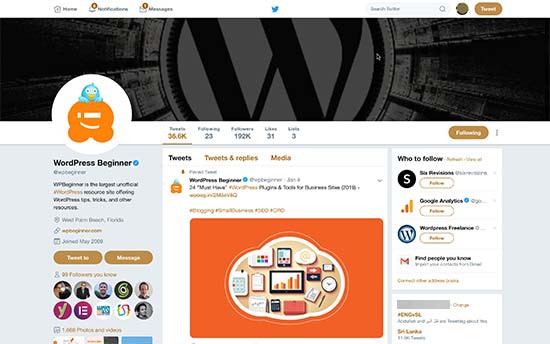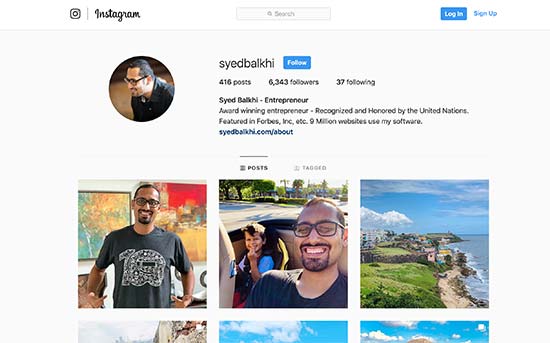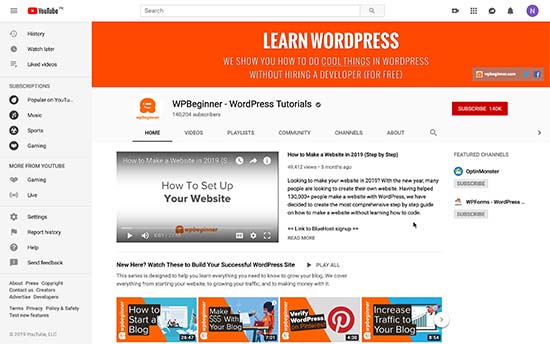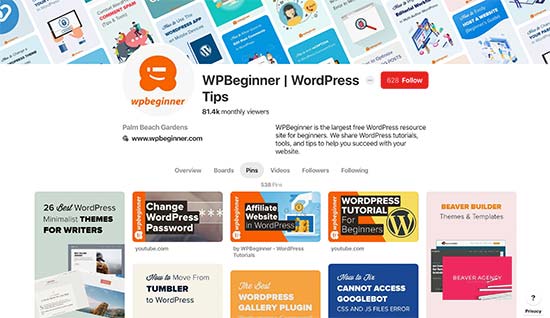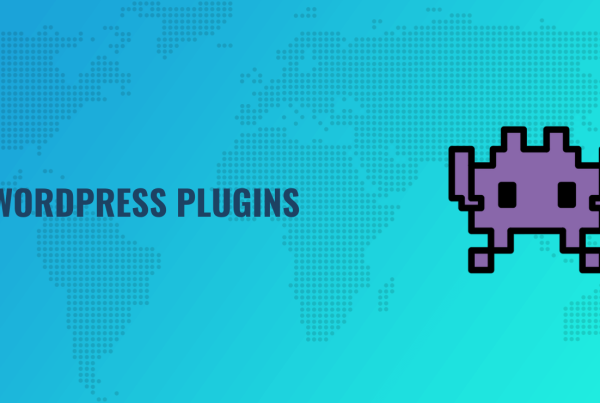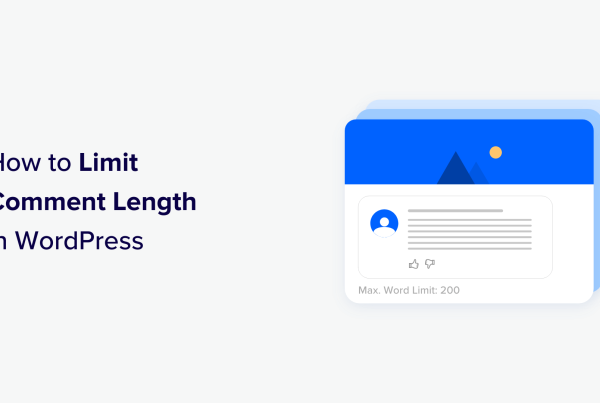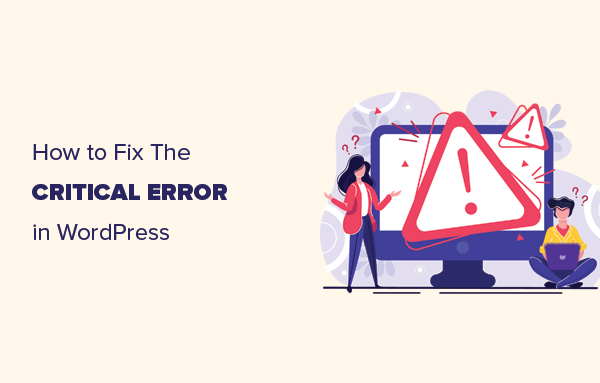If you are serious about your website or blog, then you simply can’t ignore social media. The problem is that each of these platforms has different requirements for cover photos, profile image, article cover, etc.
This makes it quite overwhelming for new users to get started.
What if there was an easier social media cheat sheet that you can follow to quickly setup all social media profiles, the right way? Something that acts as a social media checklist for image sizes, share images, automated shares, etc.
In this article, we will share our ultimate social media cheat sheet for WordPress. The goal is to help you quickly manage your social media settings for WordPress without getting distracted.
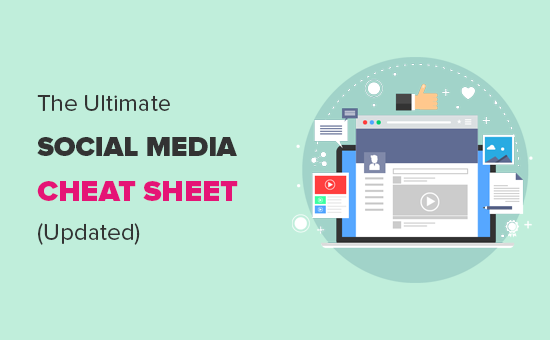
Why You Need a Social Media Cheat Sheet for WordPress?
If you have been running social media profiles for your blog or website, then you would notice that each platform has different requirements.
For example, Facebook image size has specific requirements while Pinterest needs totally different proportions.
It could be difficult to remember all that information when creating social media images for your articles or profile.
A cheat sheet helps you quickly look up all these options. It will also ensure that you don’t miss anything important when creating a social media profile or publishing a new article on your website.
That being said, let’s get started with our ultimate social media cheat sheet for WordPress users.
Here is a quick overview of the things we will cover in this article:
- Choose your social media platforms
- Social media image sizes checklist
- Setting up social media optimization in WordPress
- Social media settings for WordPress posts and pages
- Adding social sharing buttons to your website
- Setting up automated social sharing in WordPress
1. Choose Your Social Media Platforms
There are so many social media websites, but not all of them are helpful in growing your business or bringing traffic to your website.
Apart from bigger sites like Facebook and Twitter, you can choose niche platforms that work best with your website’s target audience.
For example, if you run a fashion blog, then you may want to utilize Instagram to promote your content.
A food and recipe blog may want to focus on YouTube and Yummly.
A home decor or DIY website may find Pinterest more helpful in finding the right audience.
Choosing the right platforms for your target audience will help you create an effective social media marketing strategy to grow your business.
Social Media Image Sizes Checklist
To promote your blog or business on social media websites, you will need to setup profiles, upload your website logo, cover photo, and create images to accompany your articles and links.
You can see our article on how to easily create images for your WordPress blog to learn how to make beautiful images without hiring a graphic designer.
Now the problem is that each social media platform has specific requirements for these images. Not using the right size would make your images look skewed or stretched.
Here is our quick cheat sheet for social media image sizes that you can use when creating images for your social accounts.
- Facebook image sizes
- Twitter image sizes
- Instagram image sizes
- YouTube image sizes
- Pinterest image sizes
- LinkedIn image sizes
Facebook Image Sizes
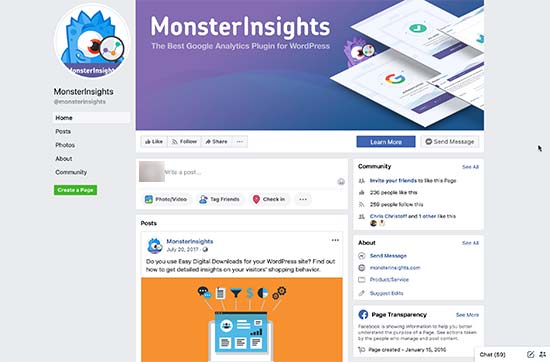
Facebook has specific recommendations for images to be used in different areas.
Cover image: 820 x 312 pixels. Cover images should be less than 100 KB in filesize. It could be in jpeg or png file format. You can create a larger image while maintaining the same aspect ratio, Facebook will automatically create smaller sizes to display on mobile devices.
Profile image: An square image of at least 180 x 180 pixels. For business pages, this is where you would ideally display your custom logo. This image will be cropped to display in a circle.
Shared Image: 1200 x 630 pixels. This image will be displayed on your page with a maximum width of 470 pixels and in the feed maximum width of 504 pixels.
Group cover image: 1640 x 856 pixels.
Twitter Image Sizes
Twitter is the internet’s conversation hub. Following are the recommended image sizes for Twitter to make your profile more engaging and professional.
Header image: 1500 x 500 pixels. This full-width image appears as the cover image of your Twitter profile page.
Profile image: 400 x 400 pixels. This square image is cropped to be displayed in a circular format.
In-stream image: 440 x 220 pixels. This image is displayed when you share an article, retweet, embed a tweet, upload images, and more. If you are already using Twitter Cards then Twitter will be able to pick the correct image to display with your article description and title.
Instagram Image Sizes
Instagram’s main content is already in visual format. If you are uploading photos directly from your phone using the Instagram app, then it will automatically take care of appropriate image sizes for you.
For other uploads, you can follow these Instagram image size recommendations for the best results.
Profile image: 110 x 110 pixels. You can use larger image dimensions as long as it is a square image.
Image thumbnail: 161 x 161 pixels. This image is displayed as your thumbnails for your photos.
Shared photos: 1080 x 1080 pixels. You can use a higher resolution image as long as it is an square image.
Shared videos: 1080 pixels wide.
Instagram Stories: 1080 x 1920 pixels or minimum 600 x 1067 pixels. File size cannot exceed more than 4 GB which is quite a lot for a high-quality video.
YouTube Image Sizes
YouTube is not only the second most popular social media platform but also the second most popular search engine. Your YouTube channel image, cover image, and video thumbnails are crucial in getting more views for your videos.
YouTube Channel cover image: 2560 x 1440 pixels. You need to make sure that the image is horizontally centered so that it looks good on mobile devices where YouTube may crop the image to fit screensize.
Channel icon: 800 x 800 pixels. This image is displayed as your channel icon and may sometimes be cropped as a circular image.
Video thumbnail: 1280 x 720 pixels. Ask any YouTube creator and they will tell you that the video thumbnail is the most important part of video optimization on YouTube. This is what YouTube users will see on their homepage, in search, and other areas. A highly optimized video thumbnail helps you get more views and grow your channel.
Pinterest Image Sizes
Pinterest is a visual social sharing platform, which means images play the most significant role in growing your Pinterest following.
Profile image: 165 x 165 pixels. You can upload an higher resolution image with maximum filesize of 10 MB.
Profile cover: Select a board to feature as your profile’s cover. Pinterest will automatically fetch pins from that board to create your profile cover.
Board cover image: 222 x 150 pixels. Pinterest allows you to choose the cover image from the pins you have saved for that board.
Pinned image preview: 236 pixels wide. Pinterest automatically scales your pins to fit their grid. For best results, you need to upload the images with an aspect ratio of 2:3 to 1:3.5.
LinkedIn Image Sizes
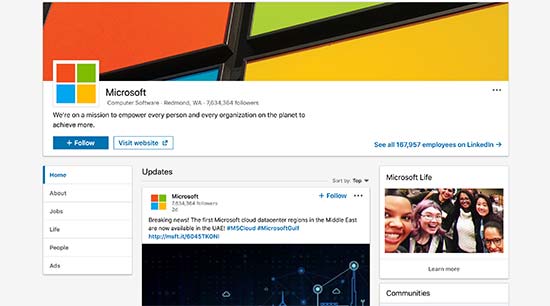
LinkedIn can be a great source of traffic, connections, and building a brand image. It is a social networking platform for professionals and businesses, which makes it a powerful tool to help you grow your business.
Personal profile image: 400 x 400 pixels with a maximum image file size of 10 MB.
Banner image for personal profile: 1584 x 396 pixels with a maximum file size of 4 MB.
Company cover image: 1536 x 768 pixels.
Shared image: 1104 x 736 pixels.
Company profile / logo image: 300 x 300 pixels or higher resolution image with 1:1 aspect ratio.
Company page banner image: 646 x 220 pixels.
Setting up Social Media Optimization in WordPress
Now that you have learned about proper social media image sizes, the next step is to make sure that your WordPress site is optimized for social media.
The most important aspect of this optimization is to setup automatic inclusion of open graph meta data. Open Graph metadata is a technology that allows you to include additional information to your web pages that social media and search engines need.
First, you need to install and activate the Yoast SEO plugin. For more details, see our step by step guide on how to install a WordPress plugin.
Yoast SEO is the best WordPress SEO plugin that helps you get more traffic from search engines. It is also a complete website optimization tool including support for social media platforms as well.
Upon activation, you need to visit SEO » Social page. From here, you need to first add your social media profile URLs under the ‘Accounts’ tab.
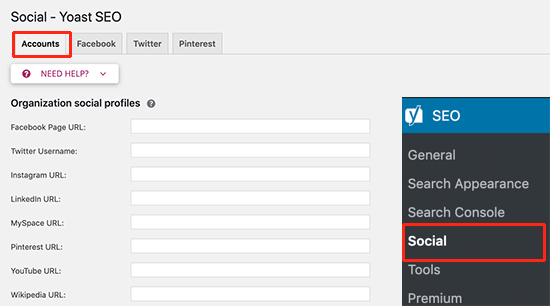
You don’t need to add all URLs, you can simply skip the social media websites where you don’t have a profile.
Next, you need to switch to the Facebook tab. From here you need to click on the toggle button to enable Open Graph metadata.
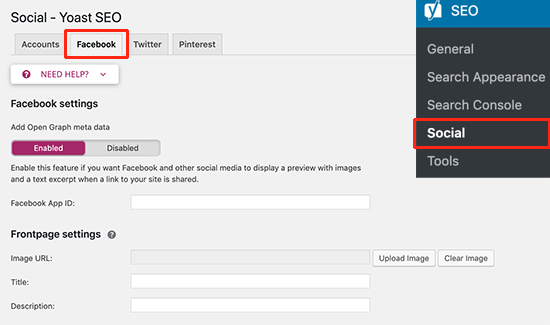
Below that you need to provide an image, title, and description for your website’s front page. The image you provide here will be displayed when someone shares your website’s front page or root URL on Facebook.
Next, switch to the Twitter tab and enable Twitter cards for your website. Below that, you can choose the default card display for your website.
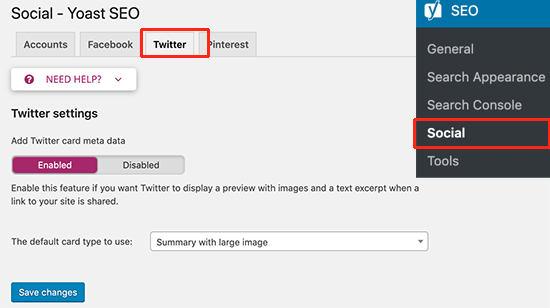
Summary with large image option will display your Twitter share image with a summary of your article.
You can now switch to the Pinterest tab. From here you can add the Pinterest confirmation tag to your website. You can click on the link on the screen to claim your website and get the confirmation code.
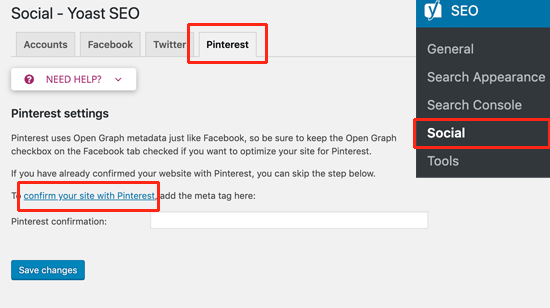
Don’t forget to click on the save changes button to store your settings.
Social Media Settings for WordPress Posts and Pages
Just like the SEO settings for posts and pages, you can also optimize them for social media websites.
Yoast SEO plugin allows you to easily set social options for your individual posts and pages.
Simply edit the blog post or page you want to optimize, and then scroll down to ‘Yoast SEO’ section below the editor.
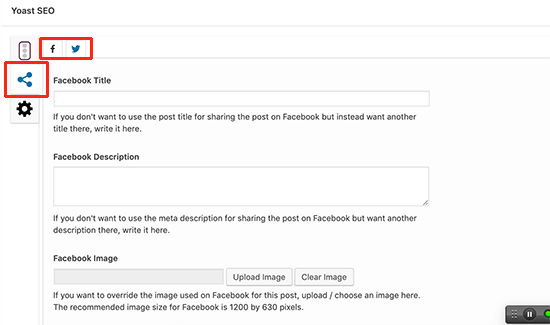
Switch to the social tab by clicking on the share icon. From here, you can upload a custom title and description as well as share image for Facebook and Twitter.
After that, you can save or publish your post.
If you want to see how your post would appear when shared, then you can do so by using the Facebook debugger or Twitter card validator tools.
Simply enter your post or page’s URL and these tools will show you how your post would look when shared on these platforms.
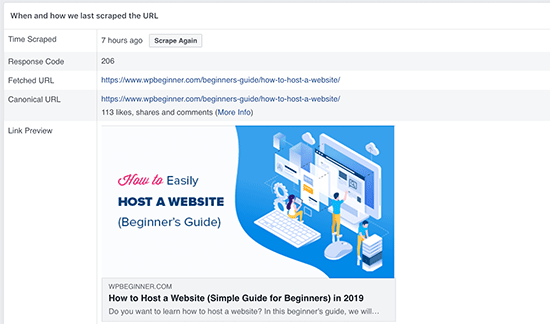
Adding Social Sharing Buttons to Your Website
The easiest way to promote your website on social media is by encouraging your users to share your content. This can be achieved by adding social sharing buttons to your blog posts and pages.
First, you need to install and activate the Shared Counts plugin. For more details, see our step by step guide on how to install a WordPress plugin.
Shared Counts is the best social media plugin for WordPress. It allows you to easily add social sharing buttons to your WordPress blog posts.
Upon activation, simply head over to Settings » Shared Counts page to configure plugin settings.
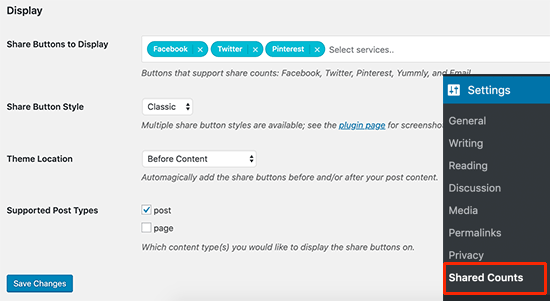
From here you need to scroll down to the display section and select the social media websites you want to display. After that, you can choose a button style and location where you want to display the buttons.
Don’t forget to click on the save changes button to store your settings.
You can now visit any post on your website to see social sharing buttons in action.
For more detailed instructions, see our guide on how to add social share buttons in WordPress.
Setting up Automated Social Sharing in WordPress
Social media platforms are great for building a following and bring more traffic to your website. However, it can become quite time-consuming to share content across different platforms and engage with your audience.
Luckily, there are several online tools that you can use to automate the process.
- IFTTT – A popular free tool that allows you to connect your WordPress site to several popular social media platforms and automatically share new content. See our guide on how to automate WordPress and social media using IFTTT.
- Revive Old Posts – This plugin allows you to automatically re-share old blog posts to your social media profiles at regular intervals. Learn more in our tutorial on how to automatically share your old WordPress posts.
- Buffer – It allows you to set up a queue of social media updates and publish them on your preferred schedule.
- MonsterInsights – Helps you easily track social media traffic using Google Analytics. This helps you learn how your posts are performing on social media websites. For details, see this guide on how to track social media traffic with Google Analytics.
We hope this social media cheat sheet for WordPress helped you improve your social media marketing strategy. You may also want to see our list of best content marketing tools and plugins for WordPress.
If you liked this article, then please subscribe to our YouTube Channel for WordPress video tutorials. You can also find us on Twitter and Facebook.
The post The Complete Social Media Cheat Sheet for WordPress (Updated) appeared first on WPBeginner.

